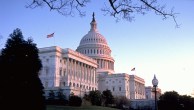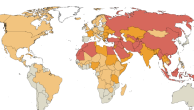In a new series of occasional reports, “Religion and the Courts: The Pillars of Church-State Law,” the Pew Forum on Religion & Public Life explores the complex, fluid relationship between government and religion. Among the issues to be examined are religion in public schools, displays of religious symbols on public property, conflicts concerning the free exercise of religion, and government funding of faith-based organizations.
Over the last three decades, government displays of religious symbols have sparked fierce battles, both in the courtroom and in the court of public opinion. Indeed, disputes over seasonal religious displays have themselves become an annual holiday tradition. Each year as the winter holidays approach, Americans across the country debate the appropriateness of the government sponsoring, or even permitting, the display of Christmas nativity scenes, Hanukkah menorahs and other religious holiday symbols on public property.
The Pillars of Church-State Law
The Legal Status of Religious Organizations in Civil Lawsuits March 2011 Are legal disputes involving churches and other religious institutions constitutionally different from those involving their secular counterparts, and if so, how?
Government Funding of Faith-Based Organizations May 2009 The debate over the meaning of the Establishment Clause.
Free Exercise and the Legislative and Executive Branches October 2008 A look at state and federal statutes that protect religious freedom.
Free Exercise and the Courts October 2007 The courts have grappled with the meaning of the Free Exercise Clause.
Religious Displays and the Courts June 2007 Government displays of religious symbols have sparked fierce battles.
Religion in the Public Schools October 2019 Americans continue to fight over the place of religion in public schools.
Polls show that a large majority of Americans support this type of government acknowledgment of religion. In a 2005 survey conducted by the Pew Research Center, 83 percent of Americans said displays of Christmas symbols should be allowed on government property. In another 2005 Pew Research Center poll, 74 percent of Americans said they believe it is proper to display the Ten Commandments in government buildings.
The Supreme Court first addressed the constitutionality of public religious displays in 1980 when it reviewed a Kentucky law requiring public schools to display the Ten Commandments in classrooms. The court determined that the Kentucky measure amounted to government sponsorship of religion and was therefore unconstitutional. According to the court, the law violated the First Amendment’s Establishment Clause, which prohibits government from establishing a religion and from favoring one religion over another, or from favoring religion generally over nonreligious beliefs.
Four years later, the court took up its first case that specifically involved holiday displays. In that case, the court ruled that a Christmas nativity scene that the city of Pawtucket, R.I., had placed in a municipal square was constitutionally acceptable. The court stated that the nativity scene simply recognized the historical origins of the holiday, one that has secular as well as religious significance. In those circumstances, the justices concluded, the nativity scene did not reflect an effort by the government to promote Christianity.
Since these two decisions in the 1980s, the Supreme Court and lower federal courts have issued somewhat unpredictable rulings, approving some religious displays while ordering others to be removed. For instance, five years after approving the Pawtucket nativity scene, the Supreme Court ruled that a nativity scene on the staircase of a Pittsburgh, Pa., courthouse was unconstitutional. In that instance, the court concluded that, unlike the situation in Pawtucket where the crèche was shown together with more secular symbols, the Pittsburgh crèche was prominently displayed on its own and thus amounted to a government endorsement of religion.
In 2005, the court ruled divergently in two cases involving permanent displays of the Ten Commandments. In one instance, the court decided that the relatively recent placement of the Ten Commandments in courthouses in two Kentucky counties violated the Establishment Clause because a “reasonable observer” would conclude that the counties intended to highlight the religious nature of the document. In the other case, however, the court ruled that a display of the Ten Commandments that had stood for more than 40 years on the grounds of the Texas state Capitol did not violate the Establishment Clause because a reasonable observer would not see the display as predominantly religious.
In reaching these decisions, the Supreme Court has relied heavily on a close examination of the particular history and context of each display and has largely sidestepped setting clear rules that would assist lower courts in deciding future cases. One result is a great deal of uncertainty about whether and how communities can commemorate religious holidays or acknowledge religious sentiments.
The lack of clear guidelines reflects deep divisions within the Supreme Court itself. Some justices are more committed to strict church-state separation and tend to rule that any government-sponsored religious display violates the Establishment Clause. These same justices also believe that, in some circumstances, the Establishment Clause may forbid private citizens from placing religious displays on public property.
Other members of the court read the Establishment Clause far more narrowly, arguing that it leaves ample room for religion in the public square. In recognition of the role that religion has played in U.S. history, these justices have been willing to allow government to sponsor a wide variety of religious displays. In addition, they have ruled that the Establishment Clause never bars private citizens from placing religious displays in publicly owned spaces that are generally open to everyone.
A third set of justices has held the middle and, so far, controlling ground. This group takes the view that a religious display placed in a public space violates the Establishment Clause only when it conveys the message that the government is endorsing a religious truth, such as the divinity of Jesus. For these justices, this same principle applies whether the display is sponsored by the government or by private citizens.
These divisions and occasional shifts have led to what many observers say are conflicting or inconsistent decisions on displays that are strikingly similar. Whether the appointments to the Supreme Court of Chief Justice John Roberts and Justice Samuel Alito will clarify the picture remains to be seen. Regardless, the struggles over public religious displays have confirmed Justice Oliver Wendell Holmes’ observation in 1890: “We live by symbols.” He might have added that we fight over them too.
Photo credit: Corbis




